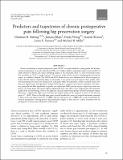Predictors and trajectories of chronic postoperative pain following hip preservation surgery

View/
Author
Sieberg, Christine B.
Klajn, Justyna
Wong, Cindy
Bowen, Garrett
Simons, Laura E.
Millis, Michael B.
Published Version
https://doi.org/10.1093/jhps/hnx003Metadata
Show full item recordCitation
Sieberg, Christine B., Justyna Klajn, Cindy Wong, Garrett Bowen, Laura E. Simons, and Michael B. Millis. 2017. “Predictors and trajectories of chronic postoperative pain following hip preservation surgery.” Journal of Hip Preservation Surgery 4 (1): 45-53. doi:10.1093/jhps/hnx003. http://dx.doi.org/10.1093/jhps/hnx003.Abstract
Abstract Factors contributing to chronic postoperative pain (CPOP) are poorly defined in young people and developmental considerations are poorly understood. With over 5 million children undergoing surgery yearly and 25% of adults referred to chronic pain clinics identifying surgery as the antecedent, there is a need to elucidate factors that contribute to CPOP in surgical patients. The present study includes patients undergoing hip preservation surgery at a children’s hospital. The HOOS and SF-12 Health Survey were administered to 614 pre-surgical patients with 421 patients completing follow-up (6-months, 1-year and 2-years post-surgery). Pain, quality of life, and functioning across time were examined for each group within the population. A three trajectory model (low pain, pain improvement and high pain) emerged indicating three categories of treatment responders. Pain trajectory groups did not differ significantly on gender, pre-surgical age, BMI, prior hip surgery, surgical type, joint congruence or Tönnis grade. The groups differed significantly from each other on pre-surgical pain, pain chronicity, quality of life and functioning. Those in the high pain and pain improvement groups endorsed having pre-surgical depression at significantly higher rates and lower pre-surgical quality of life compared to those in the low pain group (P < 0.01). Those in the high pain group reported significantly worse pre-surgical functioning compared to those in the pain improvement (P < 0.0001) and low pain groups (P < 0.0001).The results demonstrate the need for preoperative screening prior to hip preservation surgery, as there may be a subset of patients who are predisposed to chronic pain independent of hip health.Other Sources
http://www.ncbi.nlm.nih.gov/pmc/articles/PMC5467405/pdf/Terms of Use
This article is made available under the terms and conditions applicable to Other Posted Material, as set forth at http://nrs.harvard.edu/urn-3:HUL.InstRepos:dash.current.terms-of-use#LAACitable link to this page
http://nrs.harvard.edu/urn-3:HUL.InstRepos:33490702
Collections
- HMS Scholarly Articles [17920]
Contact administrator regarding this item (to report mistakes or request changes)

